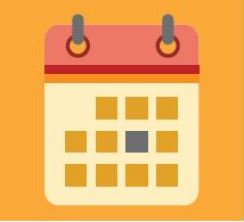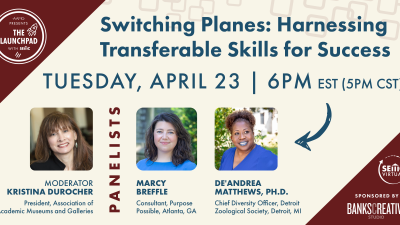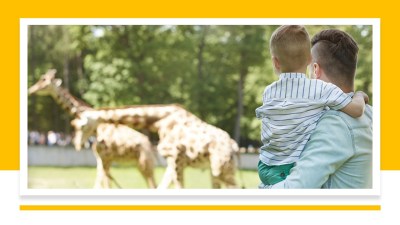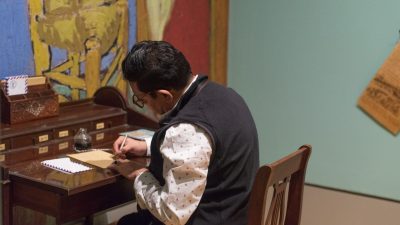
This article appeared in the March/April 2017 issue of Museum magazine.
Effective leaders create mission statements to shape their museum careers.
The one thing that can be said universally about people who work in the museum profession is that they’re here by choice. Nobody really twisted anybody’s arm to work among beautiful objects or bewildering specimens. with fascinating or curious stories, or in interesting, even unique spaces. We’re here because We’ve been drawn to this work. And many of u.s have come from a dizzying array of backgrounds to call a museum our professional home.
But once you’re in the profession, what then? Whether you’re just starting out or you’ve been around for a while, there are career crossroads to be navigated, some sooner rather than later, some by choice, others not What’s the career prize you have your eye on and have you figured out the directions you can take to eventually grab it? How important is it to have your career all planned out? And don’t we negate the serendipity, the excitement, and sometimes the fear of the unknown by being overly prescriptive? Besides, how can anybody plan like that in a time when looking ahead even six months is a futile business?
Creating a Mission Statement
It wasn’t until I had been in the field a couple of decades that I created my first professional and personal mission statements, and drafted a timeline noting past turning points and future desires. I was so happy to have an interesting and demanding job. my own income. and place of my own that I didn’t think I needed anything more than that I’d been on a pretty satisfying career trajectory. I felt, but little did I realize until much later that I had been mostly on autopilot, except for the job changes that I made primarily for more money. I wasn’t even thinking about skill development!
External forces, as it turned out, brought me to thinking about “my career” as something I could, in fact, steer, shape, or even throw over.
It’s those crazy, sometimes unforeseen, external forces that can provide a launching pad or knock you for a loop. Planning of any type, whether it’s about a career, an institution’s future, or just going to the grocery store, is difficult and often fruitless if it’s done without taking external forces into account In fact, people and organizations best weather storms when they’ve already given some thought to how they would respond to any number of variables, good and bad. Called “‘scenario planning,” although “discovery-driven planning” is perhaps more apropos, it is imperative to do now when few jobs ale lifetime locks, when museums may choose contract labor instead of salaried staff as a way to contain costs, and when many institutions are looking to be more nimble in developing and delivering programs and services.
People get together all the time to share information, network, and help sort out career questions. Our families and friends often ale our sounding boards, mostly because they’re convenient, they care about us and are, therefore, likely (or required) to listen. But they may not be as helpful as colleagues or mentors who bring the worldview of our respective professions, as well as some critical distance, to our seeking.
So where might you start in creating your own personal strategic plan? 
Put Together a Career Planning Posse
See, you can create a plan on your own. But if you’re really after some critical distance, then it makes sense to enlist trusted colleagues or mentors (who may be going through this, also) to help you bring yourself into focus. So think of this as a 360-degree evaluation-now that’s something that’s almost impossible to do alone! You’ll be the beneficiary of insights from people who see you in a variety of situations and from a variety of angles (just think about a three-way mirror in a clothing store dressing room) 
Take Stock
Every solid planning effort begins with an unvarnished inventory of internal strengths and weaknesses, and external opportunities and challenges (or threats). What are the skills and attributes you’ve got going for you? What needs work? How might you play to your strengths and mitigate those weaknesses? Do you have growth opportunities in your current job or will you need to move on to gain skills and experience? Are you in an organization where the career ladder has been stunted by staff reductions or has an increasing workload brought opportunities to learn new skills? Does small-bore thinking pervade leadership or are you able to lead effectively from where you are.
It’s tough to do this type of inventory by yourself although you certainly can. However, this is a great activity to do with your posse. Remember, your posse is here to help you evaluate yourself not decide on your value.
Assess where your career has been and where it is now, using a format that is most comfortable
for you: a narrative, a flowchart, a mind map, storyboards, charts or graphs and the like can all help (take a look at mindtools.com). Once you’ve completed your assessment, can you discern any patterns in your choices, successes, and pitfalls? Do any preferences emerge? Situations you want to stay away from in the future? In your past, can you see preludes to future directions?

Create Your Vision
What is your vision for your work? Your life? Take some time to play with these questions. In order for you to break free of the stories you might be inclined to tell, it can be quite helpful to work with images or other creative activities that can help move you to where you want to go. Always start with a prompting question like the first one in this paragraph. Other useful prompting questions might be: What do I offer a group or team? What am I passionate about? What motivates me at work? The new insights and ideas that emerge by weaving the visual and the verbal can be truly enlightening and energizing!
Now write your vision statement. Keep it short and powerful. Show it to your posse and ask for feedback. 
Build Your Plan
You are now armed with the knowledge about your strengths and weaknesses, an understanding of where your career has been, and where it could go, and why it’s important to aim in certain directions and not others. You’re ready to plot out the next steps in more depth. This is the most difficult piece for most people because it requires that you weave together a number of seemingly disparate strands into one very strong tapestry. Your goal in building your plan is to play to your strengths by aiming them at opportunities that will support your vision for your work.
You may not be successful at this personal planning stuff on your first try. That’s to be expected You must build a plan that you, and only you. are most comfortable with. This plan must encourage you to follow it, to make changes to it, and to otherwise keep it as a constant companion for as long as you need it.
For some, getting a handle on the next six months or year is plenty. A piece of poster board with your vision at the top and a month-by-month grid of six or twelve boxes might be all that’s needed to organize a handful of tasks that will start the process of refocusing your career goals. For others, a plan that articulates goals, strategies, and tasks might make more sense. The key: all must flow from your vision and all must have some kind of time frame attached (otherwise-you know the drill-all that good stuff is likely to slip by).
Ask your posse to rip it apart and help you weave it back together.

Work It
There’s an old saying that goes, ”Plan the work and work the plan.” No plan can be helpful if it never sees the light
of day. It’s now time to start completing those tasks. Put them on your calendar and start ticking them off Did you say that you wanted to contact six people and ask for an informational interview or a “pick your brains over a cup of coffee” conversation? Methodically reach out and ask for those appointments. Need more information about putting your skills to work as a consultant? Block out that research time on your calendar and keep that date with yourself and your search engine. Want to add a new skill to your toolbox? Take on a volunteer assignment that will expand your skill set and your network.
Here’s where your posse can keep you honest. There’s nothing like a periodic check-in with them to motivate you.
And last, but not least, particularly for you mid-career types and museum veterans:
Disrupt Yourself
When I read these sentences by a former Wall Street analyst-turned-entrepreneur, I found myself nodding in agreement: “Nearly everyone hits a point in their life where they examine their trajectory and consider a pivot. We typically label this mid-life crisis, but isn’t it more often a re-thinking as to which performance attributes matter? Perhaps earlier in your career the metric was money or fame, but now you want more autonomy, flexibility, authority, or to make a positive dent in the world!’ (Whitney Johnson, “Disrupt Yourself” Harvard Business Review Blog Network, August 22, 2011).
I had the good fortune to make a little bit of a disruption in my career trajectory that included some time off to recharge my batteries and re-enter the field as a servant to the museum profession rather than to a single institution. It’s a type of disruption not many think they can take, for any number of reasons (or excuses), but I can’t tell you the number of colleagues who whispered to me, “I wish I could do that!” or “You’re so brave!”
Bravery had nothing to do with it. I was completely motivated by my need to “align my ladder to a new wall. … as Marc: Freedman so aptly described it in his article, “A Gap Year for Grown-ups” (Harvard Business Review Blog Network, July 14. 2011). It was scary, and I didn’t know where my “gap year” would take me or how hard I would land. But few people knew that I had spent the previous 12 months planning my gap year.
I developed my first personal mission statement and timeline during that year. I recently returned to that work, now almost 15 years old, to help inform my new personal strategic plan.
Of course, a year off is not practical for most of us. Some would consider it professional suicide, not to mention a fast track to financial ruin. But there’s a great deal to be said for the periodic “step back,” which we routinely associate with academia as the sabbatical. The opportunity to disrupt ourselves, even for a few weeks.. is beneficial I’m heartened to see that some institutions and nonprofit funders are offering support for short-term sabbaticals, but there’s not enough of it going on in our part of the sector. There needs to be.
As each generation lives longer, many will keep working longer, too. As Freedman implores employers in his post, “help us forge a new map o£ life, one that builds in breaks more sensibly along a much longer trajectory, that is fitted to the new lifespans of the 21st century and not just for all those flagging boomers approaching the big six-oh. After all, half the children born since 2000 in the developed world are projected to see their 100th birthdays. Let’s pass on to them a life course that’s sustaining and sustainable, that pays off on the promise of the longevity revolution, for now, and for generations to come.”
What would you do if you walked into work tomorrow to learn that you’d been given a four-week break to focus on your career? Whether the impetus comes &om your institution or from that little voice deep inside yourself one thing is certain: you’d better get planning.
Anne W. Ackerson is an independent consultant and director Museum Association of New York (MANY). This article is adapted from a chapter in A Life in Museums: Managing Your Museum Career (Greg Stevens and We~ Luke, ed.,ZOJ2,AAM Press). available in the AAM Bookstore online through our partners Rowman & Littlefield.









Comments